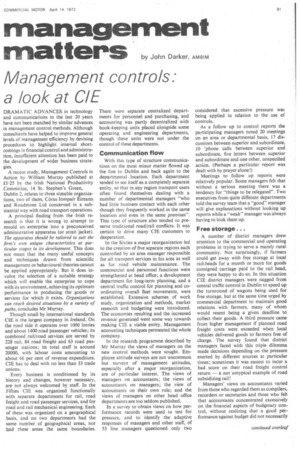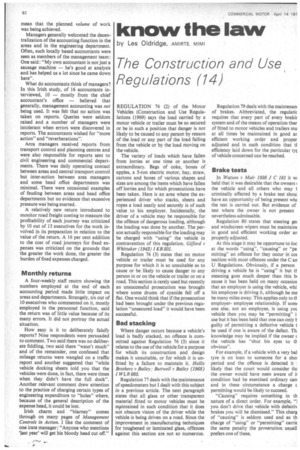management
Page 93

Page 94

If you've noticed an error in this article please click here to report it so we can fix it.
alters by John Darker, AMBIM
Management controls:
a look at CIE DRAMATIC ADVANCES in technology and communications in the last 20 years have not been matched by similar advances in management control methods. Although consultants have helped to improve general levels of management efficiency by devising procedures to highlight internal shortcomings in financial control and administration, insufficient attention has been paid to the development of wider business strategies.
A recent study, Management Controls in Action by William Murray published at f1.25 by the Irish National Productivity Committee, 14 St. Stephen's Green, Dublin 2, relates to three sizeable organizations, two of them, Coras Iompair Eireann and Roadstone Ltd concerned in a substantial way with road transport operations.
A principal finding from the Irish research is that it is wrong to attempt to mould an enterprise into a preconceived administrative apparatus (or strait jacket). The apparatus should be tailored to suit the firm's own unique characteristics at particular stages in its development. This does not mean that the many useful concepts and techniques drawn from scientific management or behavioural theories cannot be applied appropriately. But it does involve the selection of a suitable strategy which will enable the enterprise to cope with its environment, achieving its optimum performance in producing the goods or services for which it exists. Organizations can reach desired situations by a variety of paths, concludes Mr Murray.
Though small by international standards CIE is the largest company in Ireland. On the road side it operates over 1000 lorries and about 1400 road passenger vehicles; its combined rail/road services are served by 228 rail, 84 road freight and 63 road passenger stations; its total staff is around 20000, with labour costs amounting to about 66 per cent of revenue expenditure. CIE has to deal with no less than 33 trade unions.
Every business is conditioned by its history and changes, however necessary, are not always welcomed by staff. In the Fifties CIE was organized functionally with separate departments for rail, road freight and road passenger services, and for road and rail mechanical engineering. Each of these was organized on a geographical basis, and no two departments had the same number of geographical areas, nor had these areas the same boundaries. There were separate centralized departments for personnel and purchasing, and accounting was partly decentralized with book-keeping units placed alongside some operating and• engineering departments, though these units were not under the control of these departments.
Communication flow With this type of structure communications on the most minor matter flowed up the line to Dublin and back again to the departmental location. Each department tended to see itself as a completely separate entity, so that in any region transport users often found themselves dealing with a number of departmental managers "who had little business contact with each other though they frequently worked in the same location and even in the same premises". This type of structure also tended to preserve traditional road/rail conflicts. It was certain to drive many CIE customers to desperation.
In the Sixties a major reorganization led to the creation of five separate regions each controlled by an area manager responsible for all transport services in his area as well as for road vehicle maintenance. The commercial and personnel functions were strengthened at head office; a development department for long-term planning, and a central traffic control for planning and coordinating overall fleet movements, were established. Extensive schema of work study, organization and methods, market research and budgeting were introduced. The economies resulting and the increased revenue generated went some way towards making CIE a viable entity. Management accounting techniques permeated the whole company.
In the research programme described by Mr Murray the views of managers on the new control methods were sought. Employee attitude surveys are not uncommon but surveys of management attitudes, especially after a major reorganization, are of particular interest. The views of managers on accountants; the views of accountants on managers; the view of accountants on their own role; and the views of managers on other head office departments are too seldom published.
In a survey to obtain views on how performance records were used to test for pressure, and to identify the adaptive responses of managers and other staff, of 53 line managers questioned only two considered that excessive pressure was being applied in relation to the use of controls.
As a follow up to control reports the participating managers noted 20 meetings on an area or departmental basis, 17 discussions between superior and subordinate, 10 'phone calls between superior and subordinate, five letters between superior and subordinate and one other, unspecified action. (Perhaps a particular report was dealt with by prayer alone!) Meetings to follow up reports were relatively popular. Some managers felt that without a serious meeting there was a tendency for "things to be relegated". Two executives from quite different departments told the survey team that a "good" manager will give explanations without looking up reports while a "weak" manager was always having to look them up.
Free storage ...
A number of district managers drew attention to the commercial and operating problems in trying to serve a mainly rural community. Not surprisingly, if farmers could get away with free storage at local rail-heads for a month or more for goods consigned carriage paid to the rail head, they were happy to do -so. In this situation CIE district managers were nagged from central traffic control in Dublin to speed up the turnround of wagons being used for free storage, but at the same time urged by commercial department to maintain good relations with farmers, many of whom would resent being a given deadline to collect their goods. A third pressure came from higher management if planned road freight costs were exceeded when local vehicles delivered goods to farmers free of charge. The survey found that district managers faced with this triple dilemma made decisions depending on the pressure exerted by different sources at particular times; sometimes it was easiest to incur a bad score on their road freight control return — a not untypical example of road subsidizing rail!
• Managers' views on accountants varied from those who regarded them as compilers, recorders or secretaries and those who felt that accountants concentrated excessively on the financial aspects of budgetary control, without realizing that a good performance against budget did not necessarily mean that the planned volume of work was being achieved.
Managers generally welcomed the decentralization of the accounting function in the areas and in the engineering department. Often, such locally based accountants were seen as members of the management team : One said: "My own accountant is not just a sausage machine — he's good at analysis and has helped us a lot since he came down here".
What do accountants think of managers? In this Irish study, of 16 accountants interviewed, 10 — mostly from the chief accountant's office — believed that generally, management accounting was not being used. It was felt that no action was taken on reports. Queries were seldom raised and a number of managers were intolerant when errors were discovered in reports. The accountants wished for "more action" and "reverberations": Arca managers received reports from transport control and planning centres and were also responsible for reports sent to civil engineering and commercial departments. There was daily operating contact between areas and central transport control but inter-action between area managers and some head office departments was minimal. There were occasional examples of feuding between areas and head office departments but no evidence that excessive pressure was being exerted.
A relatively new return introduced to monitor road freight costing to measure the profitability of each journey was criticized by 10 out of 13 executives for the work involved in its preparation in relation to the value of the return. A 16 per cent addition to the cost of road journeys for fixed expenses was criticized on the grounds that the greater the work done, the greater the burden of fixed expenses charged.
Monthly returns
A four-weekly staff reutrn showing the numbers employed at the end of each accounting period made little impact on areas and departments, Strangely, six out of 10 executives who commented on it, mostly employed in the personnel function, said the return was of little value because of its many errors. It did not portray the actual situation.
How easy is it to deliberately falsify reports? Nine respondents were persuaded to comment. Two said there was no deliberate fiddling, two said there "wasn't much" and of the remainder, one confessed that mileage returns were wangled on a traffic report and another suggested that "while vehicle docking sheets told you that the vehicles were done, in fact, there were times when they didn't have the full dock". Another relevant comment drew attention to the practice of charging certain types of engineering expenditure to "holes" where, because of the general description of the expense head, it could be lost, Irish charm and "blarney" comes through on many pages of Management Controls in Action. I like the comment of one irate manager: "Anyone who mentions last year' will get his bloody head cut off."




















































































































































